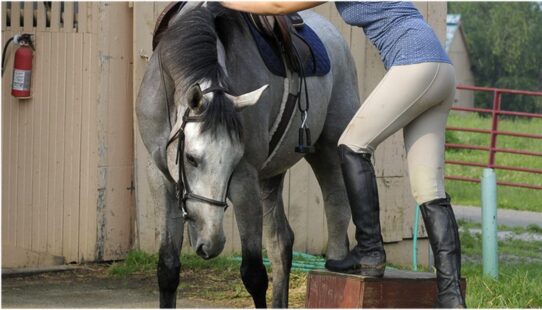Spring is just around the corner! Now is the perfect time to prepare to get back in the saddle and getting back to riding your horse. Some lucky horse owners get to ride year a round, but for many equestrians our horses don’t get exercised or ridden consistently during the winter months. It might weather (cold, snow, ice or rain)or maybe nowhere to ride with safe foot (mud, frozen ground) or limited daylight hours.
Over the winter months a horse is inactive, spends most of it’s time eating and standing around. The same can also be said for many horse owners. For humans muscle used for riding maybe out of shape, from too much time spent out of the saddle due to weather, holidays or from spending too much time on the couch snacking and bing watching Netflix.
Both horse and rider need to start out gradually building strength, and endurance to be prepared for the spring and summer riding season. Your horse’s body condition should be addressed and feed adjustments may need to be made to ensure your horse’s nutritional requirements are being met.
Feed Changes
Any changes made to your horses feeding regiment needs to be done gradually. Horses are grazing animals, in order to process their feed they rely on the bacteria in their gastrointestinal tract. A sudden change in a horse’s hay or feed can upset the healthy bacteria balance that can cause digestive upset or colic.
When changing hay or grain sources only 20% – 25% of the current feed should be changed every other day.
Dropping a few pounds
Horses just like humans can gain weight over the winter months. The best way to lose that weight for both human and horse is to eat less and exercise more.
The amount of weight a horse needs to lose varies by horse and not all horses lose weight at the same rate.
- A horse should be gradually returned to regular work and increasing duration without a change in diet.
- If feed needs to be restricted decrease the concentrated feed first (sweet feed, feeds that have added fat)
- Put horse on a forage based diet, you can have your hay tested for vitamin and mineral content and give supplement for any deficiencies in hay or pastures.
Adding body weight
- When trying to increase a horse’s weight all feed changes should be done gradually. Check with your vet if your horse has lost a significant amount of weight in a short period of time. Your vet can check for underlying medical conditions such as a dental issues.
- When feeding a horse a larger amounts of grain it is best not to exceed more than 5 pounds of grain in a single feeding. Large quantities of feed will pass through the GI tract faster than smaller meals resulting in less nutrients being absorbed and may cause digestive issue such as colic.
- Not all forage is the same the calories in hay differ depending on the source. Alfalfa has more calories per pound that most grass hays.
- To increase calorie density in feed you can add fat supplement (such as vegetable oil, rice bran), pre-formulated weight builder supplements or add highly digestible fiber options instead of just adding extra grain.
Gradual buildup of training sessions
Work sessions should increase over time:
- If your horse was performing at a high level, they will lose nearly all their conditioning due to inactivity. Start exercises and training at the lower level of work and gradually increase intensity and length training.
- Many riders get excited about getting back to work and can feed off the excitement and eagerness of their horse and may over do the first ride back.
- Like their rider, a horse can experience muscular pains and aches several days later, and since they can’t tell us in words they will often show us through actions. They may have gait stiffness, sluggishness and develop a bad attitude about working causing bucking, rearing or refuse to work.
- With an increase in work the horse’s water requirements will increase so there should have access to plenty of clean water. A horse will also need access to the electrolytes and salt to replenish any loss due to sweating.
Equipment check
Before getting back to work check you equipment. Poorly fitting or damaged tack cause a safety risk for both rider and horse. Give it a good cleaning and look for any excessively worn areas or loose stitching.
- Is the leather dry rotted or damaged?
- Is the saddle pad and other tack in good condition?
- Does your tack need adjusting to account for body changes of the horse or rider (lengthen stirrups, change gullet in a saddle)?
- How do the buckles and Velcro look?
- Is the riders equipment in good condition(helmet, boots, vest)?
With early planning you will be ready for the upcoming riding season!


Pingback: Getting Ready for Spring Riding | Dimples Horse...